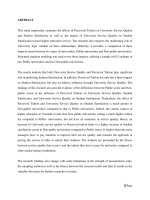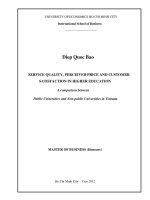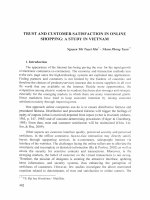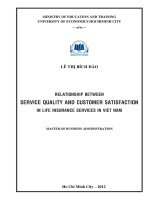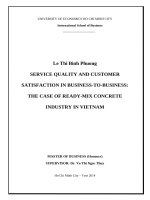E-banking services impact and customer satisfaction in selected bank branches in Ibadan metropolis, Oyo state, Nigeria
Bạn đang xem bản rút gọn của tài liệu. Xem và tải ngay bản đầy đủ của tài liệu tại đây (241.5 KB, 8 trang )
Accounting4 (2018) 153–160
Contents lists available at GrowingScience
Accounting
homepage: www.GrowingScience.com/ac/ac.html
E-banking services impact and customer satisfaction in selected bank branches in Ibadan
metropolis, Oyo state, Nigeria
Haadi Babatunde Asiyanbia and Ajibola Abdulrahamon Isholab*
Bursary Department, Federal College of Education (Special), Oyo, Nigeria
of Psychology,University of Ibadan, Ibadan, Nigeria
CHRONICLE
ABSTRACT
a
bDepartment
Article history:
Received November 1, 2017
Received in revised format
November 11 2017
Accepted March 1 2018
Available online
March 1 2018
Keywords:
E-banking
Customer satisfaction
e-transactions
Service quality
Ibadan metropolis
This study perused the impact of E-banking services on customer satisfaction of selected bank
customers in bank branches located in Challenge, Dugbe, Agbeni, Gbagi, Ojoo, and Secretariat
districts in Ibadan metropolis. The study employed a cross-sectional survey design and
convenience sampling technique. One hundred (100) bank customers were surveyed through a
self-report questionnaire. Four research questions and two hypotheses were tested using
Pearson correlation analysis and, t-test for independence at p≤ 0.05. The results revealed high
utilization of electronic banking products (ATM (98%), internet banking (85%), electronic
transfer (97%). Constraints experienced include internet network failure, bank fraud and
business loss due to failed e-transactions. Customers were satisfied with e-banking due to its
cashless nature, cash accessibility, saves time from bank visitation and seamless transactions.
The study exhibited that customers used and were glad with e-banking products. Customers’
segmentation and more investment in e-banking infrastructure were advised for promoting
electronic banking services.
© 2017 by the authors; licensee Growing Science, Canada.
1. Introduction
Electronic banking has occasioned an astounding growth in several countries particularly Africa and
has remodelled the normal banking activities in Nigeria. Ovia (2005) conceptualise Electronic banking
as providing services to customers via internet or mobile technology such as mobile phone, computers
and Automated Teller machines (ATM), etc. These services enables financial institutional customers,
people or businesses to access accounts, business transaction, or get data on monetary product through
internet telecommunication networks (Prakash & Malik, 2008). The Electronic Payment Methods
(EPM) are simplified and personalized ways of conducting financial transactions (using mobile or
internet) without involving physical cash or paper cheque reducing the instance where individuals have
to carry large sums of cash and join lengthy queues on bank premises in order to conduct financial
transaction (Jenevive & Anyanwaokoro, 2017). E-banking offers speed, efficiency, comfort and
security compared to physical banking procedures. Automated Teller Machine (ATM) and Point of
* Corresponding author.
E-mail address: (A. A. Ishola)
2018 Growing Science Ltd.
doi: 10.5267/j.ac.2018.03.001
154
Sale (POS) have eliminated the need to use cheques and paper documentation (Jenevive &
Anyanwaokoro, 2017).
Electronic payment strategies have been adapted in Nigeria advancing by the increase in the share
volume and worth of transactions accomplished through the ATM, POS, and Mobile phones, etc. For
instance the volume of transactions executed with the ATM was put at N548.60 million in 2009 and
this increased to N74.9 trillion in 2016 (Adegbesan, 2017). Thus, it is not doubtful concerning the
penetration of electronic payment approaches in Nigeria (Jenevive & Anyanwaokoro, 2017). In Nigeria
major cities and financial hubs, E-banking services are increasingly gaining ground as the customers
received them as panacea to the problems of poor quality services peculiar to the Nation’s banking
system. However, what is unknown is the level to which e-banking services have reduced the stress or
problems associated with banking and enhanced customers’ satisfaction (Taiwo & Agwu, 2017).
Emergent literature have identified that electronic banking in Nigeria is costly, occasioned by epileptic
internet services, increase in the size of cash deposits, and increased exposure to fraudulent activities
(Afolabi, 2009; Taiwo & Agwu, 2017).
In the Ibadan metropolis, banking organizations are promoting electronic banking for use among its
customers, however level of utilization seems low which was evidence with long queues at bank
branches, low deployment of POS at supermarkets and most government and private organizations still
prefer paying cash at revenue points evidenced in urban centers in Nigeria (Bello, 2005). Suggesting
that the e-banking service is possibly ignored and underutilized despite its availability. It is in view of
that the current study appraised the state of e-Banking adoption in the Ibadan metropolis and level of
satisfaction with these products in the Ibadan metropolis. Specifically, this study seeks to:
Identify the various electronic bank products presented/offered to bank customers in the
metropolis.
Describe the socio-economic characteristics of the responding bank customers.
Appraise the consumer satisfaction with electronic services offered by banks.
Evaluate the frequency at which branch visitation by customers have decline with adoption of
e-banking services.
Two hypotheses stated that:
1. E-banking have not significantly enhanced customer satisfaction among bank customers in
Ibadan.
2. The adoption of E-banking products and services has not caused a significant decline in bank
visitation.
2. Literature review
This inquiry was anchored on the Disconfirmation theory by Oliver (1980) which postulates that consumer
satisfaction with service or products is directly proportional to the magnitude and direction of the
consumers’ cognitive experience resulting from comparison of service performance and consumer
expectations. Satisfaction is consumers’ fulfilment response (Fang et al., 2010). In Nigeria, electronic
banking products are gaining ground as customers received them as solution to the challenges of
banking services delivery peculiar to Nigerian banks. E-banking have helped the banking organizations
deliver more efficient services with less processing time, improved flexibility of transactions and
reduction in overhead personnel costs (Adesina & Ayo, 2010).
Appraisal of e-banking adoption and satisfaction with the services have shown that e-banking usage
increased with the perception that it is convenient, very easy to use, reduce transaction time and flexible
(Adesina & Ayo, 2010). However, experts suggest that the rate at which Nigerians accept the products
is far below expectation (Suleimon, 2007).
H. B. Asiyanbi and A. A. Ishola / Accounting 4 (2018)
155
Addai et al. (2015) survey study demonstrated a positive association between customer satisfaction and
e-banking availability, reliability and convenience. Srivastav and Mittal (2016) investigated positive
and negative variables influencing customers’ satisfaction with Internet banking. They found that trust
and service quality was associated with internet banking services and adoption. Ismail and Alawamleh
(2017) found that e-banking adoption had a positive effect on Jordanian banks and customers’
satisfaction rates. Firdous and Farooqi (2017) in an exploratory study found that dimensions of ebanking service quality was associated with consumer satisfaction.
3. Methodology
The inquiry was conducted within the Ibadan metropolis, Oyo state, Nigeria. The Primary data collected
from cross-sectional field survey using questionnaires. The target population of the study comprised of
banks customers sampled at the premises of bank branches located in the six business districts which
include; Challenge, Dugbe, Agbeni, Gbagi, Ojoo and Secretariat Branches. These areas constitute the
major business districts in the Ibadan metropolis. In this study, 100 customers were conveniently
sampled from the customers visiting the selected branches.
3.2 Instrument
The questionnaire consisted of three parts. Part I tapped demographic information such as age, marital
status, education attainment, etc. Part II sought information perceptions and disposition to electronic
banking services. This was captured using items adapted from customers’ satisfaction with E-Banking
standardized instrument by Kumbhar (2011). The reliability was α = 0.91. The sub-dimensions of the
scale include perceived value, brand perception and cost effectiveness; easy to use, convenience,
problem handling, security/assurance and responsiveness, system availability, and fulfillment
compensation. A cumulative customer’s satisfaction index was estimated by summing the scores on all
the items. High scores on the measure suggest high gratification and vice versa. Part III sought customer
responses on frequency of visiting bank branches after embracing e-banking based on reason for
visiting the bank.4 items were scored on a Likert scale arrayed from 1 =Not all, to 5 = every day of the
week. Reliability was 0.78 Cronbach alpha. The frequency of visit index was calculated by adding all
the scores on the four items. Survey items on adoption, use of e-banking and service quality were
responded to on a Likert scale arrayed from 1= “Strongly Disagree” to 5= “Strongly Agree” using items
adapted from Kumbhar (2011). Reliability was 0.82 cronbach alpha. The section also contains items
asking questions on perceived constraints to the use and adoption of e-banking products.
3.3 Procedure
Prior to the exercise of data collection, permission was sought and secured from the relevant authorities
in the selected banks to conduct the study among its customers. In addition, research assistants were
employed and trained in data collection techniques to enable them effectively seek audience from
sampled customers.
3.4 Method of data analysis
The data was analysed using SPSS for windows version 20.0. The descriptive statistics include
frequency counts and simple percentage. The Pearson correlation statistics were used to establish the
co-variant relationship between the variables and t-test for independence used to examine differences
between variables at p≤0.05 level of significance.
4. Results
Result revealed that more than half of the respondents were males below the age of 30 years, 29 %
were age between 31 to 40 years and 21% were ≤ 40 years. 64% of the customers were married and
156
75% possessed First degree certificate, 15% had secondary school education and 10% were primary
school certificate holders. 80% of the consumers had less than 5 dependents, 13% had 5-9 dependents
and 7% had above 10 dependents. 55% of the consumers earned below =N= 200, 000, 26% earn
between =N= 201,000-=N= 500,000 and 19% earned above =N=501,000 monthly.
Table 1
Electronic banking utilization
Item
Yes
No
ATM
Internet banking
99(99%)
85(85%)
1(1%)
15(15%)
Bank transfer
97(97%)
14(14%)
31(31%)
29(29%)
3(3%)
86(12%)
69(69%)
71(71%)
E-money/purse
POS
Mobile money
Source: Authors computation
The larger percentage of the consumers reported using ATM, internet banking while only few reported
the use of bank transfer, POS and mobile money and majority reported non-utilization of Emoney/purse.
Table 2
Perception of the quality of e-banking services offered by the service provider
SD
Electronic banking makes cash readily available whenever
you need it
Using electronic banking saves time from going to the bank
Electronic banking services makes transaction easier and
safer
Electronic banking exposes one to internet fraud and credit
Electronic banking helps me to save time from visiting
branch banks to conduct banking transactions
Electronic banking allows me to conduct my business 24
hours/day without waiting for banks opening hours
DA
U
A
SA
3(3%)
15(15%)
3(3%)
50(50%)
29(29%)
3(3%)
5(5%)
6(2%)
47(47%)
44(44%)
5(5%)
3(3%)
4(4%)
48(48%)
41(41%)
10(10%)
28(28%)
10(10%)
36(36%)
16(16%)
4(4%)
5(5%)
3(3%)
50(50%)
38(38%)
7 (7%)
7(7%)
3(3%)
57(57%)
27(27%)
Source: Authors computation
79% opined that electronic banking makes cash readily available whenever need arise. 83% reported
that electronic banking saves time from going to the bank, 90% viewed that electronic banking services
makes transaction easier and safer. 52%reported that electronic banking increases their vulnerability
internet fraud and credit, 88% opined that electronic banking helps to save time from visiting branch
banks to conduct banking transactions, 84%) agreed that electronic banking allows the conduct of
baking business 24 hours/day without waiting for banks opening hours.
Table 3
Impact of electronic banking on visitation to bank branches in the last six months after embracing ebanking products
Activities to carry out at the bank
For banking transaction
For enquiry
To transfer money
To receive money
Source: Authors computation
No response
Not all
On demand
Once or
twice in a
month
3 to 4 times
in a week
Every day
of the week
18(18%)
28(28%)
33(33%)
17(17%)
9(9%)
9(9%)
11(11%)
6(6%)
35(35%)
35(35%)
28(28%)
38(38%)
30(30%)
22(22%)
25(25%)
21(21%)
8(8%)
5(5%)
1(1%)
14(14%)
1(1%)
1(1%)
4(4%)
6(6%)
157
H. B. Asiyanbi and A. A. Ishola / Accounting 4 (2018)
Table 3 shows that larger proportion (35%) of the respondents reported that with introduction of
electronic banking activities their visitation to the bank branches is now on demand, 30% now visits
the bank branches once or twice in a month. Only, 35% now visits the bank for enquiry when demanded
compare to 22% who visit once or twice in a month. 28% presently visits the bank branches to transfer
money on demand and 38% reported visiting the bank to receive money only when necessary to do so
while 21% visit the bank once or twice in a month to receive money.
Table 4
Satisfaction with electronic banking
Items
I enjoy electronic banking which affords customers to
take less cash around
I am completely satisfied with the services delivered by
my bank
I feel very pleased with services offered through
electronic banking
I feel absolutely delighted with the electronic banking
I would like to remain as a customer of my present bank
due to it electronic banking
I consider myself to be loyal to my bank and electronic
SD
DA
U
A
SA
2(2%)
8(8%)
3(3%)
48(48%)
40(40%)
3(3%)
16(16%)
38(10%)
45(45%)
26(26%)
7(7%)
15(15%)
5(5%)
46(46%)
26(26%)
3(3%)
11(11%)
11(11%)
52(52%)
24(23%)
4(4%)
13(13%)
9(9%)
47(47%)
27(27%)
3(3%)
7(7%)
8(8%)
50(50%)
33(33%)
Source: Authors computation
Significant number of the respondents agreed that they enjoy electronic banking, which affords
customers to take less cash around, makes cash readily available whenever need arise. Majority were
satisfied because electronic banking saves time from going to the bank, makes transaction easier.
Table 5
Constraints to the utilization of electronic banking
Constraints
Being stranded due to electronic banking problems
experience credit card theft/online bank fraud
Business loss or challenges due to inability transact with heavy
cash due to bank restraints
Yes
56(56.1%)
14(14%)
No
44(44%)
86(86%)
20(20%)
80(80%)
Source: Authors computation
Table 5; reveals that Constraints reported by a number of the respondents include being stranded due
to electronic banking (56%), credit card theft/online bank (14%)and business loss or challenges due to
inability to carry heavy transactions at the counter(20%).
4.2 Hypothesis testing
H1: E-banking have not significantly enhanced customer satisfaction among bank customers in Ibadan.
The hypothesis was tested using Pearson r correlational test and summary presented in Table 6.
Table 6
Pearson correlation test showing the relationship between e-product and services utilisation and Customer
satisfaction
Variables
Customer satisfaction
Utilization of electronic banking products and services
**Pearson correlation significant 0.01 level of significance (2 –tailed)
Mean
25.43
S.D
5.29
7.59
2.08
r
Df
378
378
P
.36**
<.01
158
The results obtained from the test are shown in Table 5 shows that utilization of e-banking products,
services was a positive co-variant of customer satisfaction (r = .36, p<.01) indicating that in electronic
banking products, services significantly relate to increase in satisfaction. The null hypothesis not
accepted and the working hypothesis is supported.
H 2: The adoption of E-banking products and services has not caused a significant decline in bank
visitation. The hypothesis was tested using t-test for independence statistics and summary presented in
Table 7:
Table 7
t-test summary table showing the influence of electronic banking utilisation on Frequency of bank
visitation
Level of electronic
N
Mean
S.D
df
t
P
banking utilization
Frequency of
Low utilization
104
8.85
5.44
Bank visitation
3.37
<0.01
High utilization
63
4.93
3.65 98
Results in Table 7, reveals that low utilization of e-banking products (M=8.85, S.D= 5.44) significantly
occasioned reported lower averaged frequency of bank visitation compared to high utilization of
electronic banking products (M=4.93, S.D =3.65). The result indicates that utilization of electronic
banking services reduced the constancy of bank visitation (t (98) = 3.37, p<.01). This demonstrates that
high utilization of e-banking products reduced frequency of bank visitation among the present sample.
The null hypothesis is not accepted and the working hypothesis is supported.
5. Discussion
From the results, this study has empirically demonstrated that there was a high utilization of electronic
banking products. ATM, internet banking and electronic transfer are the commonly utilized e-banking
products. This is consistent with findings from Bello (2005), Taiwo and Agwu, (2017), Adesina and
Ayo (2010). It was confirmed that internet network failure, bank fraud and business loss due failed etransactions were the common constraints reported by the customers. This is also consistent with Taiwo
and Agwu (2017), Adesina and Ayo (2010). The findings showed that there was a significant decline
in bank visitation which disagrees with earlier findings by Bello (2005). This finding however agrees
with the work of Worku et al. (2016) who found a significant decline due to the adoption of e-banking
products.
Customers were satisfied with e-banking with emphasis on its cashless nature, cash accessibility, saves
time from bank visitation and seamless transactions. This is in agreement with Firdous and Farooqi
(2017) who found association between dimensions of e-banking service quality and consumer
satisfaction. The study also demonstrated that E-banking utilization was associated with customer
satisfaction. This is in agreement with findings of Addai et al. (2015), Srivastav and Mittal, (2016);
Ismail and Alawamleh (2017) who demonstrated that e-banking services was associated with increased
customers satisfaction with banking services.
6. Conclusion and Recommendation
This inquiry has demonstrated that the patronage of e-banking products is on the increase and bank
clients are satisfied with e-banking experience. The banking organisations were advised to increase
awareness about electronic banking system through sensitizing its customers, particularly the nonadopters, about the various gains associated with e-banking so as to encourage its adoption. To further
reduce the challenges associated with users interface, graphical presentation and pictorials should be
on display at bank’s branches. The banking organizations should endeavor to minimize the costs
H. B. Asiyanbi and A. A. Ishola / Accounting 4 (2018)
159
associated with e-banking. They should not introduce fees for similar banking services that are free-ofcharge in the physical world (for example, at bank branches and/or ATMs). For further studies, it was
advised that researchers interested in future inquiry can extended the research to corporate customers,
and comparison could then be made between private and corporate customers to include factors
influencing decisions to embrace, select e-banking and services perceived to be useful. In addition, the
sample size should be increased in a study of the whole banking sector.
Acknowledgement
We declared that there is no conflict of interest, this study was entirely self-sponsored and informed
consent obtained from the respondents.
References
Addai, O., Ameyaw,B., Ashalley, E., & Quaye, I.(2015) Electronic Banking and Customer
Satisfaction: Empirical Evidence from Ghana. British Journal of Economics, Management & Trade,
9(3), 1-8. DOI : 10.9734/BJEMT/2015/19269.
Adegbesan, E. (2017, November 3) E-payment transactions up 33% to N74.9trn in 2016 —
CBN.Vanguard Newspaper. Retrieved 27/1/2018 from />Adesina, A. A. & Ayo, C.K. ( 2010) An empirical investigation of the level of users’ acceptance of ebanking adoption: A study of E-Commerce adoption. Journal of Association. Information System,
1, 1-28.
Afolabi, F. O. (2009). The role of information technology in Nigeria Banks: A case study of
Intercontinental bank. Guaranty Trust Bank and First bank PLC, p. 10.
Bello, D. A. (2005). The impact of E-banking on customer satisfaction in Nigeria. University Library
of Munich, Germany.
Fang, V. W., Tian, X., & Tice, S. (2014). Does stock liquidity enhance or impede firm innovation?. The
Journal of Finance, 69(5), 2085-2125.
Firdous, S., & Farooqi, R. (2017). Impact of Internet Banking Service Quality on Customer
Satisfaction. The Journal of Internet Banking and Commerce, 22(1), 1-17.
Ismail, L. B., & Alawamleh, M. (2017). The Impact of Online Banking of Customer Satisfaction in
Jordan. JOURNAL OF ORGANISATIONAL STUDIES AND INNOVATION, 4(2), 1-13.
Jenevive, O. C., & Anyanwaokoro, M. (2017). Electronic Payment Methods and Profitability of
Banking Firms in Nigeria: A Panel Data Analysis. International Journal of Finance and
Accounting, 6(3), 67-74.
Kumbhar, V. M. (2011). Factors affecting the customer satisfaction in e-banking: Some evidences form
Indian banks. Management Research & Practice, 3(4), 1-14.
Oliver, R. L. (1980). Theoretical bases of consumer satisfaction research: Review, critique, and future
direction. Theoretical developments in marketing, 206-210.
Ovia, J. (2005). Enhancing the efficiency of the payment system in Nigeria. CBN Bullion, 29(1), 8-18.
Prakash, A., & Malik, G. (2008). Empirical Study of Internet Banking in India. Internet Research,
12(5), 83-92.
Srivastav, G., & Mittal, A. (2016). Impact of Internet banking on customer satisfaction in private and
public sector banks. Indian Journal of Marketing, 46(2), 36-49.
Suleiman, B. (2007). Report on the Survey of Developments in the e- payments and Service Products
of Banking and other Financial Institutions in Nigeria. Central Bank of Nigeria Library, P.A
6- 14.
Taiwo, J. N., & Agwu, M. E. (2017). The role of e-banking on operational efficiency of banks in
Nigeria. Basic Research Journal of Business Management and Accounts, 6(1), 01-10.
Worku, G., Tilahun, A, & Tafa, M.A. (2016). The Impact of Electronic Banking on Customers’
Satisfaction in Ethiopian Banking Industry (The Case of Customers of Dashen and Wogagen Banks
160
in Gondar City). Journal of Business and Financial Affairs, 5, 174. doi:10.4172/21670234.1000174.
© 2018 by the authors; licensee Growing Science, Canada. This is an open access
article distributed under the terms and conditions of the Creative Commons Attribution
(CC-BY) license ( />
